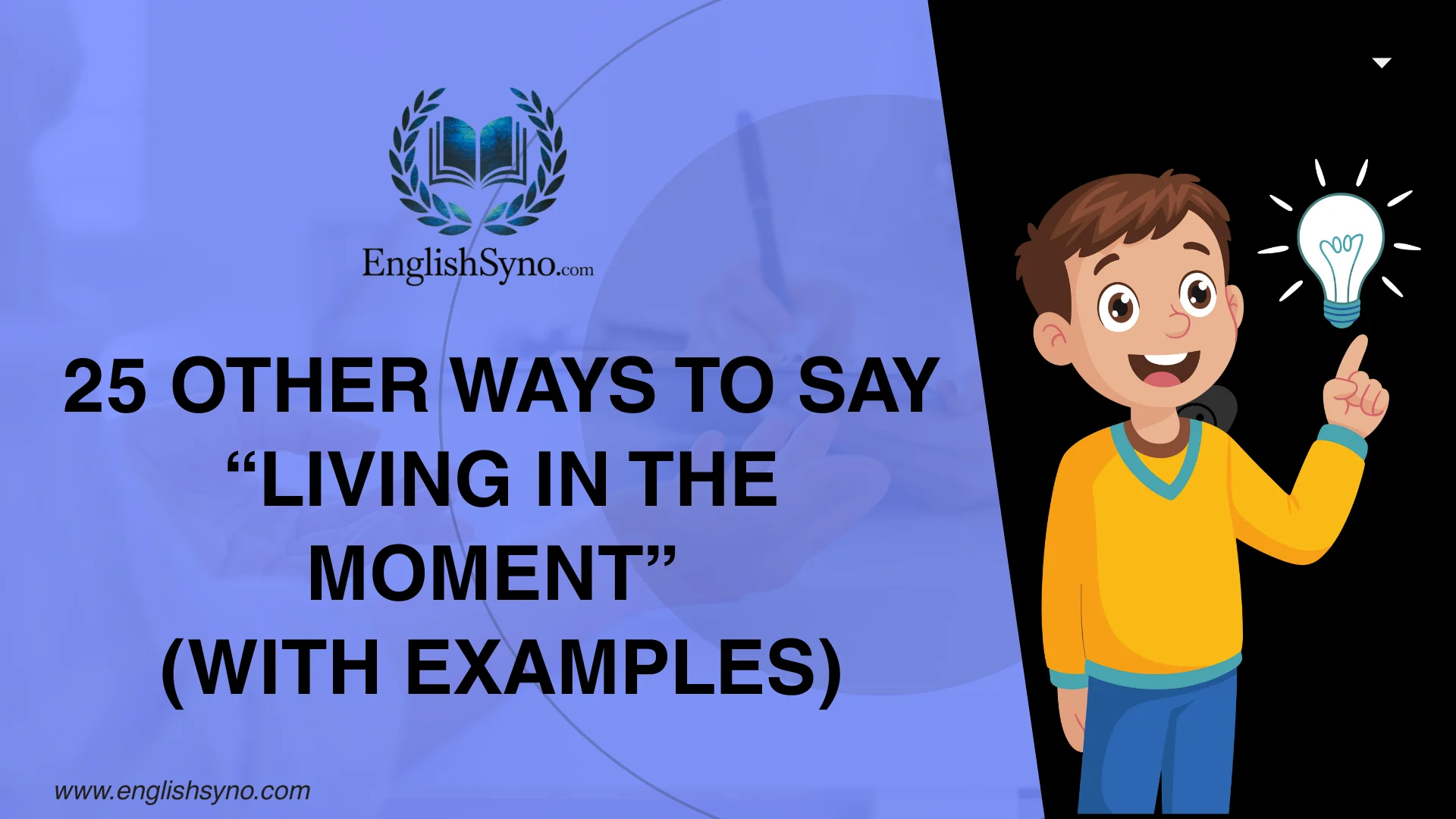Living in the moment starts by embracing the present, practicing mindfulness, and paying attention to your surroundings while limiting distractions.
Daily mindful exercise and savoring each moment enhance appreciation, forgive past hurts, cultivate gratitude, and cherish today to experience life fully.
What Does “Living in the Moment” Mean?
Definition: Living in the moment means focusing fully on the present experience, without letting worries about the past or future distract you.
Explanation: It’s about engaging with your surroundings, being mindful of thoughts and feelings, and appreciating life’s simple pleasures. Practicing this mindset can improve mental clarity, emotional balance, and overall happiness.
When to Use “Living in the Moment”
Use living in the moment when discussing mindfulness, gratitude, or enjoying experiences as they happen. Perfect for self-help, journaling, or advice to friends. Avoid in overly formal or business-heavy contexts unless adapted.
Is It Professional/Polite to Say “Living in the Moment”?
Yes, it is polite and professional in contexts that involve well-being, mindfulness, or emotional intelligence. In strictly technical or transactional settings, consider more neutral phrasing, like focusing on the present task.
Pros or Cons
Pros: Encourages mindfulness, reduces stress, promotes gratitude, and makes communication empathetic.
Cons: Can feel vague or cliché if overused, may not suit technical or formal writing.
Embracing the Present
Meaning: Fully welcoming and experiencing current circumstances without distraction.
Explanation: This phrase emphasizes acceptance and awareness. It encourages engagement with your surroundings and your feelings without judgment or worry.
Example: “I’m embracing the present by spending quality time with my family instead of checking emails.”
Best Use: Mindfulness exercises, personal growth discussions
Worst Use: Legal, business contracts
Tone: Warm, reflective, encouraging
Savoring Each Moment
Meaning: Taking the time to appreciate every experience, small or large.
Explanation: Focuses on enjoying experiences fully, paying attention to details, emotions, and surroundings.
Example: “While sipping my coffee, I paused and really savored each moment of my morning routine.”
Best Use: Personal development, lifestyle content
Worst Use: Urgent instructions, technical writing
Tone: Gentle, immersive, reflective
Being Mindful
Meaning: Practicing awareness of your thoughts, feelings, and surroundings intentionally.
Explanation: Encourages conscious attention to the present, reducing stress and increasing emotional clarity.
Example: “Being mindful during my walk helped me notice the beauty in everyday life.”
Best Use: Meditation, coaching, therapy
Worst Use: Impersonal emails, business reports
Tone: Calm, supportive, thoughtful
Enjoying the Now
Meaning: Taking pleasure in the present, without letting past regrets or future worries interfere.
Explanation: Focuses on gratitude and presence, celebrating the moment as it is.
Example: “I’m enjoying the now by listening to music and ignoring my phone notifications.”
Best Use: Social posts, lifestyle articles, conversations
Worst Use: Academic papers, formal legal contexts
Tone: Cheerful, uplifting, reflective
Experiencing Life Fully
Meaning: Engaging with life completely, with openness and awareness.
Explanation: Highlights active participation in everyday experiences and emotions.
Example: “Traveling with no fixed plans lets me experience life fully and appreciate new cultures.”
Best Use: Motivational content, journaling prompts
Worst Use: Formal reports, technical documents
Tone: Energetic, reflective, immersive
Cherishing Today
Meaning: Valuing and appreciating the current day as it happens.
Explanation: Encourages gratitude and attentiveness to life’s moments, rather than dwelling on past regrets or future worries.
Example: “I’m cherishing today by taking a long walk and noticing the small joys around me.”
Best Use: Personal reflection, lifestyle advice
Worst Use: Technical instructions, formal contracts
Tone: Warm, reflective, gentle
Seizing the Day
Meaning: Taking full advantage of the present opportunities.
Explanation: Promotes active participation and enthusiasm for what life offers now.
Example: “I decided to seize the day by finally calling an old friend I had been meaning to reconnect with.”
Best Use: Motivational content, inspirational messages
Worst Use: Formal, risk-averse contexts
Tone: Energetic, empowering, encouraging
Appreciating the Here and Now
Meaning: Recognizing and valuing the current moment without distraction.
Explanation: Focuses on awareness and gratitude for what is happening in your immediate surroundings.
Example: “During the picnic, I took a deep breath, appreciating the here and now.”
Best Use: Mindfulness exercises, reflective writing
Worst Use: Business memos, legal documents
Tone: Calm, reflective, grateful
Awareness
Meaning: Being conscious of your surroundings, emotions, and thoughts.
Explanation: Enhances clarity and emotional balance by focusing attention fully on the present moment.
Example: “Through meditation, I gained awareness of my thoughts and feelings.”
Best Use: Mindfulness, self-improvement discussions
Worst Use: Casual humor or slang-heavy texts
Tone: Neutral, reflective, calm
Conscious Engagement
Meaning: Actively participating in experiences with full attention and intention.
Explanation: Highlights commitment to present experiences rather than passive observation.
Example: “I practiced conscious engagement at the art exhibit, noticing every detail and color.”
Best Use: Coaching, workshops, mindfulness guidance
Worst Use: Casual or hurried contexts
Tone: Thoughtful, deliberate, focused
Full Engagement
Meaning: Being completely involved in an activity or experience.
Explanation: Encourages presence and depth in whatever you are doing.
Example: “During the hike, I felt full engagement with nature around me.”
Best Use: Mindfulness sessions, coaching
Worst Use: Technical reports, formal memos
Tone: Immersive, reflective, focused
Cultivating Awareness
Meaning: Developing the habit of noticing and appreciating the present.
Explanation: A practice that strengthens mindfulness and reduces distraction from worries.
Example: “By cultivating awareness, I noticed the small beauty in my daily routine.”
Best Use: Self-help, lifestyle blogs
Worst Use: Transactional writing
Tone: Calm, instructive, reflective
Deeper Connection
Meaning: Forming a meaningful relationship with the present moment or experience.
Explanation: Encourages emotional richness and mindfulness in interactions and experiences.
Example: “Spending time in nature allowed me a deeper connection with myself and the world.”
Best Use: Reflective writing, wellness coaching
Worst Use: Impersonal emails
Tone: Emotional, warm, contemplative
Savoring
Meaning: Taking the time to fully enjoy and appreciate experiences.
Explanation: Focuses on mindful enjoyment and attention to detail in everyday life.
Example: “I stopped and savored the taste of my morning coffee.”
Best Use: Lifestyle writing, mindfulness tips
Worst Use: Rushed or technical communication
Tone: Gentle, appreciative, reflective
Enhances Appreciation
Meaning: Improves the recognition of value in life or experiences.
Explanation: Being present helps you notice and value things you might otherwise overlook.
Example: “Walking in the park enhances appreciation for small moments of beauty.”
Best Use: Reflective writing, wellness guidance
Worst Use: Formal, legal writing
Tone: Warm, encouraging, thoughtful
Life’s Simple Pleasures
Meaning: Enjoying small, everyday joys fully.
Explanation: Emphasizes mindfulness and gratitude for ordinary moments.
Example: “I’m noticing life’s simple pleasures, like the smell of fresh rain.”
Best Use: Personal blogs, mindfulness coaching
Worst Use: Technical manuals
Tone: Cheerful, calm, reflective
Liberates
Meaning: Frees the mind from worries about the past or future.
Explanation: Being present liberates you from stress and promotes mental clarity.
Example: “Meditation liberates me from anxious thoughts about the day ahead.”
Best Use: Mindfulness, wellness guidance
Worst Use: Casual business notes
Tone: Empowering, reflective, calm
Future Anxieties
Meaning: Concerns about upcoming events that distract from the present.
Explanation: Focusing on the moment reduces future anxieties and enhances peace.
Example: “Yoga practice helps me let go of future anxieties.”
Best Use: Self-help, mindfulness discussions
Worst Use: Urgent work instructions
Tone: Supportive, calming, reflective
Unique Beauty
Meaning: The special qualities in each moment that make it valuable.
Explanation: Encourages noticing details and emotions that might otherwise go unnoticed.
Example: “Watching the sunset, I felt the unique beauty of the world around me.”
Best Use: Reflective, inspirational writing
Worst Use: Transactional or formal communication
Tone: Poetic, warm, contemplative
Each Moment
Meaning: Referring to the importance of appreciating every instant.
Explanation: Highlights mindfulness and presence in daily experiences.
Example: “I try to notice the joy in each moment, no matter how small.”
Best Use: Journaling, lifestyle advice
Worst Use: Technical instructions
Tone: Gentle, reflective, mindful
Living for the Moment
Meaning: Acting and thinking fully in the present without unnecessary worry.
Explanation: Encourages embracing opportunities and experiences as they come.
Example: “Traveling without a strict plan helps me live for the moment.”
Best Use: Travel blogs, lifestyle content
Worst Use: Strict schedules, formal communication
Tone: Free-spirited, uplifting, encouraging
Carpe Diem
Meaning: A classic Latin phrase meaning “seize the day.”
Explanation: Encourages action and enjoying the present before it passes.
Example: “I told myself carpe diem and finally started my passion project.”
Best Use: Motivational writing, inspirational speeches
Worst Use: Legal or formal documents
Tone: Energetic, empowering, motivational
Active Participation
Meaning: Fully engaging in an activity with awareness.
Explanation: Being proactive and present rather than passive.
Example: “Joining the community clean-up gave me active participation in making a difference.”
Best Use: Community activities, mindfulness workshops
Worst Use: Passive or remote work instructions
Tone: Engaged, encouraging, motivating
Experiencing Life Fully
Meaning: Engaging completely with experiences and emotions.
Explanation: Encourages openness, gratitude, and depth in all moments.
Example: “By traveling without an itinerary, I’m experiencing life fully.”
Best Use: Self-development, travel blogs
Worst Use: Formal reports, technical documentation
Tone: Reflective, immersive, empowering
Valuing Life
Meaning: Recognizing the importance and preciousness of each moment.
Explanation: Promotes gratitude, mindfulness, and appreciation for the present.
Example: “Spending time with loved ones helps me value life more.”
Best Use: Inspirational, lifestyle content
Worst Use: Impersonal or transactional communication
Tone: Heartfelt, reflective, motivating
Final Thoughts
Mastering the art of living in the moment is more than a catchy phrase; it is a mindset that fosters mindfulness, emotional clarity, and a deeper appreciation of life. By embracing the present, savoring each moment, and being mindful, we create space to fully engage with our experiences, relationships, and surroundings. Daily practices such as mindful exercise, meditation, and simply pausing to appreciate the here and now help liberate the mind from future anxieties and regrets about the past. When we cherish today and commit to active participation in life, we notice the unique beauty in even the smallest moments, reinforcing a sense of gratitude and fulfillment.
These strategies are not just abstract concepts-they are practical tools for building a calmer, more aware, and emotionally resilient life. Whether through carpe diem, living for the moment, or experiencing life fully, each approach invites us to focus on what truly matters, reducing stress and enhancing our overall well-being. Incorporating these practices into daily routines can transform ordinary moments into meaningful experiences, cultivating a deeper connection with ourselves and others. Ultimately, living in the moment encourages a life of presence, awareness, and joy, reminding us that the richness of life unfolds when we fully embrace it, one moment at a time.
FAQs
What does “living in the moment” mean?
It means focusing entirely on the present, being mindful of your thoughts, feelings, and surroundings, without distraction from past regrets or future worries.
How can I practice living in the moment?
You can practice mindfulness, meditate, savor everyday experiences, limit distractions like social media, and engage fully in activities that make you feel connected.
Why is living in the moment important?
It improves mental clarity, reduces stress, enhances emotional resilience, and allows for a deeper appreciation of life’s simple pleasures.
Can living in the moment improve relationships?
Yes, being fully present enhances empathy, communication, and emotional connection with friends, family, and colleagues.
What are some simple exercises to be present?
Mindful breathing, meditation, journaling, nature walks, and savoring meals without distractions are effective techniques.
Is it professional to talk about living in the moment?
Yes, in wellness, coaching, or reflective contexts, it is polite and professional. Avoid in strictly technical or legal contexts.
Can living in the moment reduce anxiety?
Absolutely, focusing on the present helps release future anxieties and reduces stress caused by overthinking.
How does mindfulness relate to living in the moment?
Mindfulness is the practice of paying full attention to the present, making it the foundation for living in the moment.
Can it improve productivity?
Yes, being present allows better focus, fewer distractions, and more deliberate decision-making in daily tasks.
How is “carpe diem” connected to living in the moment?
Carpe diem is a Latin phrase meaning “seize the day,” encouraging action and enjoyment of present opportunities.
What are common mistakes when trying to live in the moment?
Getting distracted by digital devices, overplanning, or fixating on past regrets can hinder mindfulness.
How long should I practice mindfulness daily?
Even 5–15 minutes of consistent practice, like meditation or mindful breathing, can be highly effective.
Can children practice living in the moment?
Yes, simple exercises like observing nature, playing without distractions, or mindful storytelling help kids focus on the present.
Does living in the moment conflict with planning for the future?
Not at all; it encourages awareness now while still allowing thoughtful preparation for upcoming tasks.
How do I know if I’m successfully living in the moment?
You feel calmer, more focused, appreciative, and less distracted by past regrets or future worries, noticing the richness in each moment.



